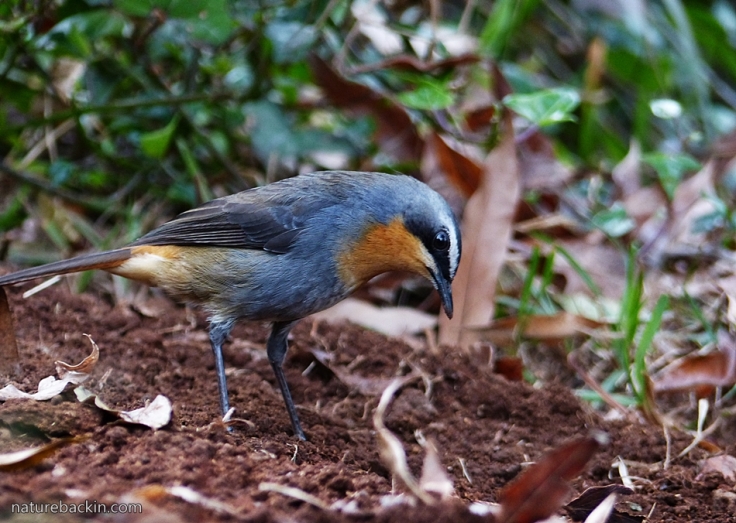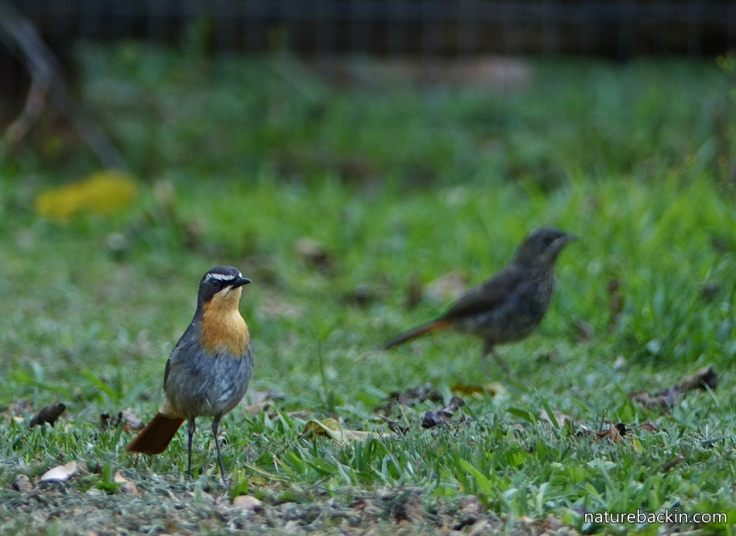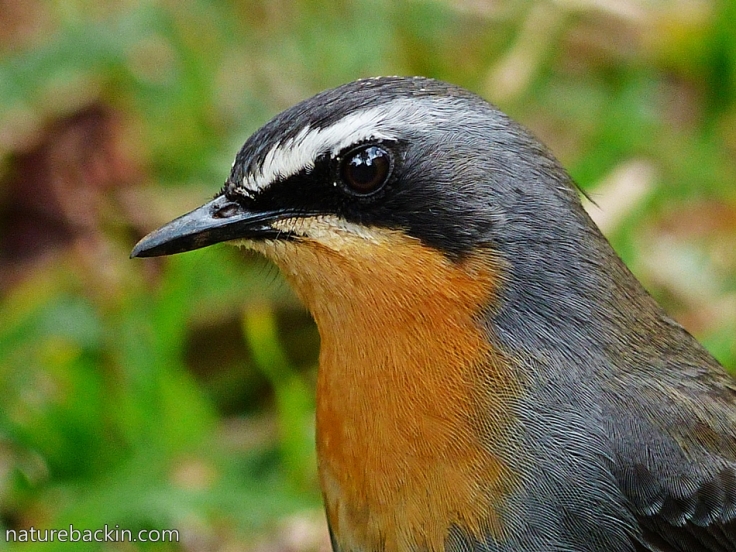The Cape Robin-Chat rather paradoxically can be shy as well as confiding. These lovely little birds occur over much of South Africa where there is dense enough vegetation to provide for their needs.
Like thrushes and other robins and robin-chats, they are predominantly ground foragers, although they can hawk on the wing, and they also glean prey from foliage and tree trunks. They have adapted well to gardens and parks. Their varied diet includes many insects, especially beetles, ants, moths, termites and caterpillars and they also eat ripe fruits.

Cape Robin-Chats often forage near to or on the ground when concealed by low-growing vegetation, but they also venture out onto garden lawns seeking prey

A Cape Robin-Chat watching from a fence post in our garden for prey to feed its hungry fledgling baby in the late afternoon

This Cape Robin-Chat took advantage of my bit of gardening to venture near to see what it might find in freshly exposed earth
Male and female Cape Robin-Chats look alike. Although they are territorial birds and form monogamous breeding pairs when the opportunity arises, they mostly forage on their own. They advertise their territory by singing loudly, though females only do this in the absence of a male. They can also mimic the calls of other species. There is a Cape Robin-Chat on record that mimicked the calls of 36 species of birds, resulting in it having about 75 different calls (Roberts VII Multimedia PC Edition).

A parent Cape Robin-Chat keeping an eye out for prey to feed to its constantly chirping baby (in the background) that has recently fledged
Both parents share in raising their young. There are usually 2-3 eggs per clutch. Nests can be on the ground or in low-growing vegetation. Sometimes they make use of human-built structures and even pot plants to house their nests.
Cape Robin-Chats are commonly parasitized by the much bigger Red-chested Cuckoo (Piet-my-vrou), and I have seen a pair working very hard to feed the very vocal and very large cuckoo fledgling that they were raising.

I managed to snap a closer shot of the same Cape Robin-Chat fledgling as in the photo above. It was very wary and alert despite it seeming to be fixated on demanding food from its parent

Cape Robin-Chats prefer to bathe daily if water is available. This one is taking a dip in the shallow end of our garden pond. In coastal areas they have been seen bathing in intertidal rock pools

This individual, also enjoying bathing in the garden pond, is a juvenile in the process of acquiring its adult plumage
Cape Robin-Chats moult post-breeding, with the timing of this process varying across summer-and winter-rainfall regions. Their colour is at its most vivid after acquiring their new feathers, and their feathers become more bleached in appearance over time.

A portrait of a Cape Robin-Chat showing its white eye-brow and the lovely orange wash on its throat and chest
 Sources: Hugh Chittenden, Greg Davies, Ingrid Weiersbye. 2016. Roberts Bird Guide: Illustrating nearly 1,000 Species in Southern Africa (2nd edition). Cape Town: Jacana; Roberts VII Multimedia PC Edition. 1997-2016 Southern African Birding. For details go to http://www.sabirding.co.za/roberts7/portal.html
Sources: Hugh Chittenden, Greg Davies, Ingrid Weiersbye. 2016. Roberts Bird Guide: Illustrating nearly 1,000 Species in Southern Africa (2nd edition). Cape Town: Jacana; Roberts VII Multimedia PC Edition. 1997-2016 Southern African Birding. For details go to http://www.sabirding.co.za/roberts7/portal.html
Posted by Carol









December 10, 2020 at 7:57 am
How do you tell the difference between a male and female?
LikeLiked by 1 person
December 10, 2020 at 8:43 pm
As far as I know, male and female Caper robin-chats are alike. One difference in behaviour is that only the female incubates the eggs when breeding, but both male and female feed and raise the youngsters.
LikeLike
June 20, 2020 at 10:12 am
Great article and lovely photos, Carol. I love these birds too. You’re right that they enjoy insects and fruit, they also like cheese! I have actually filmed Cape Robin-Chats eating cheese at my bird feeder a number of times. They really do enjoy it! 🙂
– Rory
LikeLiked by 1 person
June 20, 2020 at 8:05 pm
Thank you Rory. Interesting how the Cape robin-chats enjoy the cheese
LikeLike
February 22, 2019 at 8:03 am
We have two that live around our workshop. Amazing how they become tame very quickly. They are always picking up crumbs on the floor so I wondered what they ate. Now I know what to do with ripe fruit. 🙂
LikeLiked by 1 person
February 22, 2019 at 8:40 am
Yes they are quite confiding birds and lovely to have around. I wonder if your two might be nesting nearby when the time is right.
LikeLike
August 27, 2018 at 11:28 am
Very informative reading and beautiful photographs!
LikeLiked by 1 person
August 27, 2018 at 8:12 pm
Thanks very much Belinda.
LikeLiked by 1 person
August 27, 2018 at 2:01 am
Marvelous photography and to learn about this charming bird is indeed a pleasure.
LikeLiked by 1 person
August 27, 2018 at 5:12 am
Thanks Gunta.
LikeLike
August 26, 2018 at 3:21 pm
I feel privileged when Cape Robin-chats venture nearby and love listening to their contribution to the dawn chorus. These are beautiful photographs.
LikeLiked by 1 person
August 26, 2018 at 7:32 pm
Thanks Anne. I feel the same way about the Cape Robin-chats.
LikeLike
August 25, 2018 at 12:16 am
What a sweet-looking bird. Your photos are terrific, Carol.
LikeLiked by 1 person
August 25, 2018 at 8:20 pm
Thanks Eliza. Yes it is a very appealing little bird.
LikeLike
August 24, 2018 at 1:11 pm
Lovely post and the photos are wonderful.
LikeLiked by 1 person
August 25, 2018 at 8:20 pm
Thanks Arc. It is a lovely little bird.
LikeLiked by 1 person
August 24, 2018 at 10:27 am
One of my favourites.
LikeLiked by 1 person
August 25, 2018 at 8:17 pm
Mine too.
LikeLike
August 24, 2018 at 6:53 am
What charming – and useful – chaps to have around.
LikeLiked by 1 person
August 25, 2018 at 8:14 pm
Definitely a favourite 🙂
LikeLiked by 1 person
August 24, 2018 at 3:57 am
I love the coloring of these birds. And they are much like the American Robin in their love of bathing and ground foraging…..especially if freshly tilled.
LikeLiked by 1 person
August 25, 2018 at 8:13 pm
Interesting to hear that they have similar habits to the American Robin.
LikeLiked by 1 person
August 25, 2018 at 8:19 pm
Yes, must be genetic overlap there.
LikeLiked by 1 person
August 23, 2018 at 10:36 pm
Very interesting and great photos as always. One can only wonder what these birds think when they find themselves raising a cuckoo several times larger than themselves.
LikeLiked by 1 person
August 25, 2018 at 7:56 pm
Thanks. I suppose that once the baby cuckoo hatches and evicts the eggs/nestlings of the hosts, the poor robin parents are programmed to raise what remains to them, but it is a strange process. Being a bird parents seems to be demanding enough even with a robin-sized baby to raise!
LikeLiked by 1 person